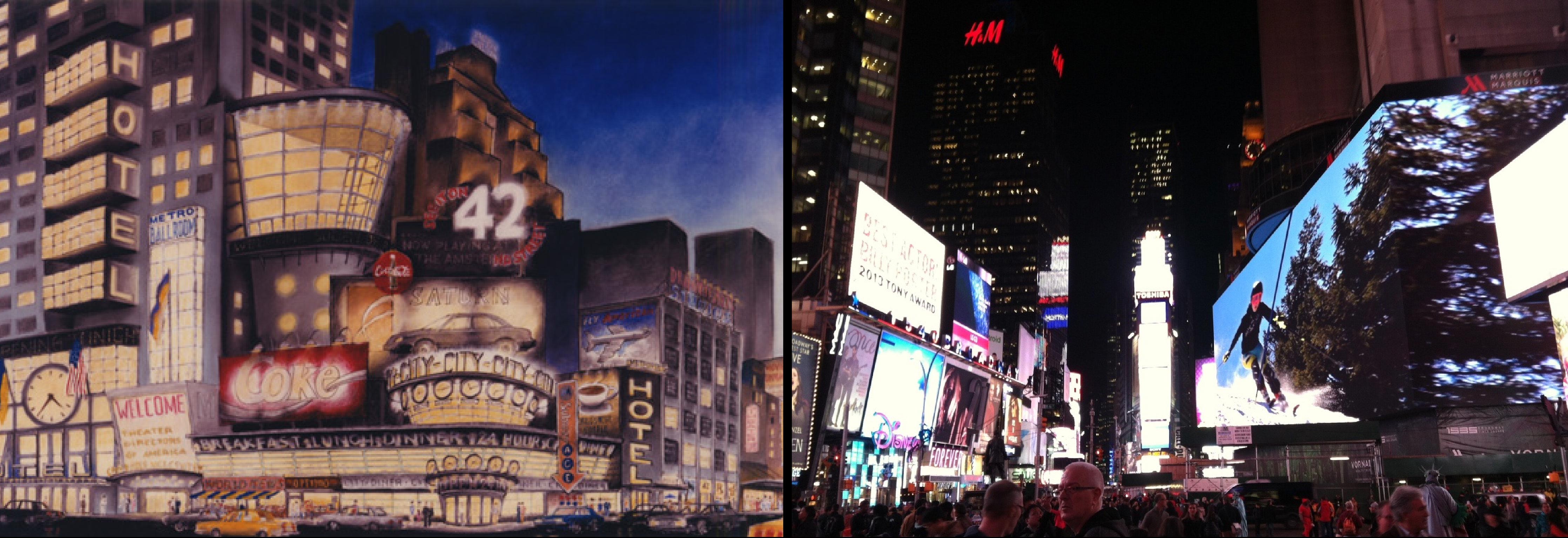The Skyscraper Museum is devoted to the study of high-rise building, past, present, and future. The Museum explores tall buildings as objects of design, products of technology, sites of construction, investments in real estate, and places of work and residence. This site will look better in a browser that supports web standards, but it is accessible to any browser or Internet device.

Left: 42nd Street Now!, 1993. Rendering of design guidelines for vibrant signage and a mix of retail and entertainment uses for 42nd St., developed by RAMSA and Tibor Kalman for the Empire State Development Corp. Courtesy of Robert A.M. Stern Architects Right: The bow-tie of Times Square, November 2015, introducing the Vornado mega-sign. Photo: Carol Willis
In conjunction with its exhibition TIMES SQUARE, 1984, The Skyscraper Museum presented a series of programs that reunited key actors in the transformation of Times Square over the past three decades.
New York Chapter Planning and Urban Design Committee
TIMES SQUARE AT A TIPPING POINT?
Center for Architecture, 536 LaGuardia Pl.
Times Square at a Tipping Point? 2.17.15 from Center for Architecture on Vimeo.
Speakers: Kent Barwick, Claire Fellman, Bruce Fowle, Lynne Sagalyn, and Paul Whalen
Introduction by Lance Jay Brown. Overview by Carol Willis, Director, The Skyscraper Museum
Government actions in the 1980s and 90s designed to control rampant crime in Times Square, foster the westward expansion of the midtown office district, protect the theater industry and preserve historic theaters, and return 42nd Street as a popular entertainment area have been a success. The bright lights of Broadway were saved from threats of dimming, or even banishment, first by civic groups such as the Municipal Art Society who organized protests, then by revised zoning regulations that mandated minimum areas of signage and outlined urban design guidelines. Collectively, these civic and government actions succeeded in articulating and codifying Times Square's unique, historical sense of place.
As an economic engine for the city and an unparalleled magnet for tourists, Times Square's turnaround in the past decades is phenomenal. The reduced vehicular traffic and new pedestrian plazas allow almost enough ground space for the 360,000 visitors a day to the world's #1 tourist ticker. But other forces threaten its future: mega-signs; high rents; corporate homogeneity; errant Elmos. This program of experts on Times Square past and present will consider pressing questions about its future.
The panel was co-sponsored by the AIA New York Chapter Planning and Urban Design Committee.
Speakers:
KENT L. BARWICK was president of the Municipal Art Society from 1983 to 1995, and again form 1999 through 2009. From 1978 to 1983, he was Chairman of the New York City Landmarks Preservation Commission. Currently, he is chairman of the State Council on Waterways.
CLAIRE FELLMAN, a landscape architect, is a Director in the New York office of Snohetta. She leads the firm's Times Square Reconstruction Project, which is scheduled for completion in 2015.
BRUCE FOWLE is a Founding Principal at FXFOWLE Architects, an architectural, planning, interior design, and sustainability firm. His work has earned the firm a number of major design awards, including National AIA Honor Awards for the Conde Nast Building at 4 Times Square, the first green skyscraper in the United States, and the New York Times Building (with Renzo Piano). The firm also designed the Thomson Reuters Building at 3 Times Square.
LYNNE B. SAGALYN is the author of Times Square Roulette, the definitive history of Times Square's redevelopment. She is the Earle W. Kazis and Benjamin Schore Professor of Real Estate and Director of the MBA Real Estate Program at the Columbia University Graduate School of Business. She is currently finishing a book on the rebuilding of The World Trade Center.
PAUL WHALEN, a Partner at Robert A.M. Stern Architects, has been with RAMSA since 1981. His work has focused on place-making at various scales. He was partner-in-charge of two of the country's most influential planning projects: the new town of Celebration, Florida, and, with Tibor Kalman, the plan and guidelines that revived the theater block of New York City's 42nd Street. The urban design guidelines known as 42nd Street Now! for the Empire State Development Corporation won a 1999 Honor Award from the American Institute of Architects

These programs were supported, in part, by public funds from the New York City Department of Cultural Affairs.
These programs were supported, in part, by public funds from the New York State Council for the Arts, a State Agency.
This program is part of NYC Landmarks50 Alliance, the multi-year celebration of the 50th anniversary of New York City's Landmarks Law

